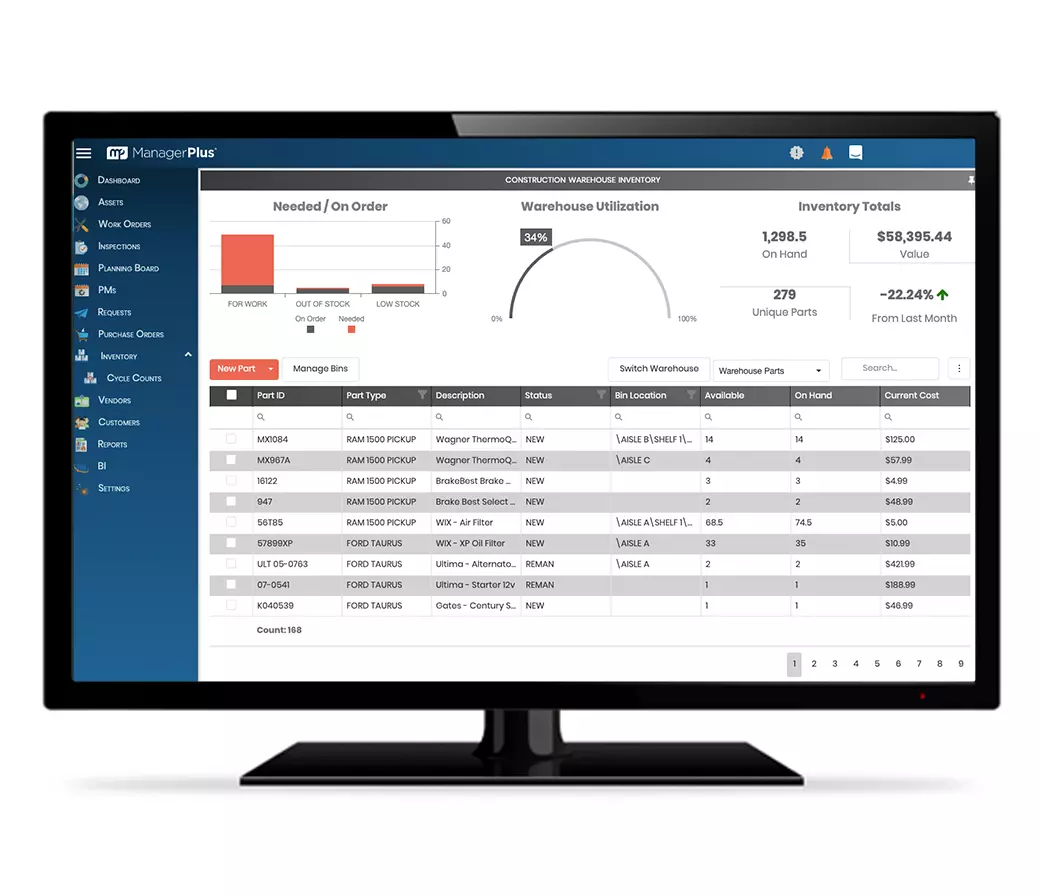Tired of your asset management operations feeling uncoordinated?
When everyone is only focused on meeting their daily requirements without considering their broader impact on your organization’s assets, your assets aren’t living up to their full potential.
An asset management policy, backed up by robust asset management software, is the recipe your team needs to make sure you’re getting the most from your assets.
The basics of asset management
Assets are anything that is regularly used by an organization to help it reach its goals. Anything from physical assets like buildings and vehicles to intangible resources like people and money can all be considered assets. Assets can also include things like computers and desks that are used in areas beyond direct production and maintenance.
If there’s any piece of equipment, tool, or resource that is used to help a company achieve certain objectives, you can consider it an asset.
The goal of asset management is to develop and implement systems to optimize the value obtained from your assets. Beyond simply keeping equipment online and functioning, asset management looks to optimize value across every aspect of the asset’s life at your organization. From purchase to maintenance, to upgrades, and finally, disposal, asset management systematically approaches every asset intending to maximize its value to the organization.
Asset management policy definition
An asset management policy is the roadmap your organization follows to effectively manage its assets to maximize value. The idea of an asset management policy is to get everyone who works with your assets on the same page as to how your organization makes decisions regarding your assets. The idea is to empower everyone in your organization, from the equipment operators to the executives, to take part in actively making decisions about your assets that will benefit the organization as a whole.
Instead of everyone thinking individually about how the assets and equipment simply helps them do their jobs so they can go home, an asset management policy gets everyone involved and bought in to actively contributing toward improving the value of your assets to help the entire organization thrive.
An asset management policy is good for business
Managing your assets effectively to ensure you’re maximizing their value can be tricky. There is a lot involved which requires resources from many different departments across your organization. That’s one of the main reasons why a clear asset management policy can be so effective. It unifies everyone’s efforts, making sure your entire team is moving in the same direction concerning your assets.
Developing a strong asset management policy for your organization helps you:
- Optimize processes
- Maintain compliance
- Improve safety
- Reduce costs
- Increase maintenance team value

Increase the efficiency of your asset management operations
You’ve heard the phrase, “too many cooks in the kitchen.” The idea is that when you have too many people trying to do their own thing without following any sort of cohesive plan, things get chaotic, and the end result is not as good as it could have been.
The same is true of asset management. If everyone on your team, including your operators, technicians, managers, and executives are all simply following their own plans to get things done, you might be able to keep things running and get stuff done, but it won’t be the most efficient way to do things. You’re essentially leaving money on the table.
When you take the time to build out and implement a strong asset management policy, everyone can now follow the same recipe that you know will get you the results you want. When everyone in the kitchen, from the line cooks to the sous chef is working together, the result is a hot, delicious meal.
An asset management policy clearly defines each person’s role within your asset management operations and encourages the team to look for ways your operations can be improved. The increased efficiency also translates to a reduced backlog, fewer costs, better inventory management, and more.
Maintain compliance and adhere to best practices
Maintaining compliance with industry and government regulations is a way of life for any organization and having an asset management policy in place goes a long way in helping you do that. In fact, having an asset management policy in place is one of the core requirements of the ISO 55001:2014 industry standard.
Keep your team safe
While there are many industry recommendations and best practices to follow when building your asset management policy, yours should be designed to highlight the best practices that are specific to your organization. Every company has different goals and objectives, and your asset management policy should reflect that.
You and your team know your assets and organization better than anyone so you can make sure that safety is a top priority when building your asset management policy. Using our kitchen example from earlier, you all know the dangers of working in the kitchen, so you can keep those things in mind as you’re building your policy.
Your asset management policy is there to get everyone on the same page and working together to accomplish your goals, and when everyone has clear expectations to follow, they are more likely to perform tasks and procedures that yield the best results. The best results don’t always mean the fastest results. A large part of having an asset management policy in place is to help your team work quickly, cost-effectively, and most importantly, safely.
Cut your maintenance costs
There’s a reason so many companies strive to improve efficiency—it almost always leads to cost savings, particularly in the long term. When your team is operating more efficiently, costs come down.
One of the most noticeable ways is through better asset maintenance. As your maintenance team gets more efficient at their jobs, they perform more preventive maintenance tasks as opposed to simply reacting to equipment failures.
Preventive maintenance reduces the amount of unscheduled downtime for your equipment, which according to the Aberdeen research group, can cost an average of $260,000 per hour. Having an asset management policy in place streamlines your processes so your team can keep your equipment online.
Get the entire organization involved in asset management
While many organizations are happy to leave the managing of assets to the maintenance team, everyone in your organization has an impact on your assets in one way or another. This means that if you don’t have buy-in from the rest of the organization to improve your asset management operations, there’s no way you’ll ever achieve optimal efficiency.
Building an asset management policy is a great way to get everyone at your organization involved in managing your assets, particularly when executive leadership gets involved in building the policy. Most people in an organization who aren’t part of the maintenance or facility management teams, don’t consider the equipment they use regularly as assets that can be efficiently managed. They just don’t think about it in general.
An asset management policy with the backing and support of executive leadership better defines the asset your company has and helps everyone begin to think more strategically about how they use equipment and can get involved in the process of using them more efficiently.
This also sheds more light on just how valuable the maintenance team is to the company at large. Most people tend to only think about the maintenance team when there’s a problem but giving them more ownership of your company assets by showing how everyone is working towards a common goal show the rest of the organization how valuable the maintenance team is.

Crafting an asset management policy
Your asset management policy is a high-level, overarching document that clearly defines the role that asset management has in your organization and how everyone in the company can contribute to it.
One of the main things to keep in mind is that you want your policy document to be short and concise. There is a lot of important information to convey, but a lengthy, confusing document won’t help anyone.
State the purpose
To properly set the tone of your policy document, begin by stating its purpose. Clearly define for your team the reason behind the asset management policy and what you hope to gain by implementing it at your organization. Tie in your company’s vision or mission statement and any core values that you can to help align it with your overall company objectives.
State the scope
It’s important to state what your asset management policy covers. You obviously won’t want to list every single asset your company owns but talk with people in different parts of the organization to get a full picture of what assets you do have and who’s responsible for them.
State the intended outcomes
What are the goals you’re hoping to achieve through your asset management operations? Define your objectives clearly and align them with your overall company strategy. This is also where you explain the reasoning behind the policy and how it will benefit your employees and your organization.
State the principles
You might want to lay out some of the basics of asset management so you can have a documented template of some of the basics of decision-making for the assets at your organization. This won’t necessarily be for your asset management and maintenance team specifically, but it can help someone else who isn’t directly involved with your asset management make appropriate when needed.
State the responsibilities
One of the most crucial aspects of your asset management policy is defining who is responsible for developing, managing, and implementing your policy. It’s ok to keep things high-level, again, you don’t want to get wordy and complicated, but be sure to list out who is responsible for which stage of your policy. For instance, executive leadership might have the final say over the approval of the policy, but it will be up to the department managers to implement it for their teams.
State the commitment
An asset management policy is a firm commitment from your company and its leadership to manage your assets responsibly. This includes compliance with industry regulations and standards as well as working to maximize the value of your assets.
This commitment is important for your internal teams, so they know that the company is working to benefit everyone in the organization, but external shareholders often demand and expect high levels of responsibility as well. Having a well-documented asset management policy proves you are committed to improving the efficiency of your asset management operations which increases the overall value of your organization.
A large part of this commitment is a promise to continually update and improve your asset management policies often. Industries are constantly changing and as new technology and experience are gained, regulations, standards, and best practices evolve as well. Part of a strong asset management policy is a commitment to regularly improve and update your policy.
State the additional resources
It’s a good idea to include any related resources in your policy document, particularly if your document is based on specific standards such as the ISO 55001:2014 standard. If you think a short glossary of industry terms and definitions would be beneficial for some members of your organization, this section is a great place for those.
This section also includes administrative details like the date the policy becomes effective, the date the policy will be reviewed and/or updated, who owns and is responsible for the policy, which member of the leadership team is sponsoring the document, etc.
Implementing an asset management policy
Crafting a great asset management policy is just the first step. The policy document itself is worthless unless the policy itself becomes a part of your organization’s culture. The goal of your asset management policy is to get everyone involved in improving your asset management operations but if no one pays attention to the document, then all the work creating it was wasted.
Communicate
As with relationships, communication is the key to success. You may create the world’s greatest asset management policy, but if no one knows it exists, then it’s nothing more than a piece of paper. If you can’t prove that you communicated the policy to your team, then it’s hard to keep them accountable for it down the road.
Part of communicating the document effectively is making it easily accessible to everyone in the company. If it’s short enough, hang it up in high-traffic places around your facility. Make sure anyone can easily access it on your company’s database and consider creating a summary document or presentation or even a short video to make the policy even more accessible.
Provide your team with an easy way to provide suggestions and recommendations to the policy as well. Everyone in your company will be part of implementing the policy and as such, they should be able to take part in the evolution of the document.
Monitor and improve
Once the policy is in place, it’s vital that whoever is responsible for the policy has some way to continually monitor the success of the policy. Tracking procedures and their results are key components of asset management and the same applies to your asset management policy. However they choose to do it, the project leader should monitor your policy’s implementation and clearly define how they measure its success.
In your policy, you should have clearly stated your commitment to improving and updating it so make sure you adhere to that. Set regular intervals in which you will evaluate your policy and update it if necessary.
Use the right tools
Every job needs the right tool. To build a car, you need a wrench. To catch a fish, you need a rod. And to implement an asset management policy, you need EAM software.
Enterprise asset management, or EAM, software is not just a tool, but an entire toolbox that helps you implement and track the success of your asset management policy effectively.
 With EAM software, you can capture up-to-the-minute data on your asset management and maintenance operations and can track the impact of your asset management policy in real time. You can generate detailed business intelligence reports on the KPIs that you want to track to see how well your operations are aligning with your company goals.
With EAM software, you can capture up-to-the-minute data on your asset management and maintenance operations and can track the impact of your asset management policy in real time. You can generate detailed business intelligence reports on the KPIs that you want to track to see how well your operations are aligning with your company goals.
But you can get even more granular than that. If one of the goals of your asset management policy is to improve the efficiency of your maintenance team, then use EAM software to build custom work order templates with checklists that include guidelines from your policy. You can then track your work orders by asset, by technician, by shift, or however you choose so you can quickly see how good your policy is or find places you can improve upon it.
The best EAM software platforms, like ManagerPlus from iOFFICE, live in the cloud so all the data you collect is always available, instantly, across any Internet-connected device in your organization. If making your asset management operations more efficient is one of your policy goals, implementing ManagerPlus can have an immediate impact.
Asset Management Policy Summary
Effective asset management is all about improving their value to your company. This involves a lot of moving parts and a lot of different resources from across your organization. With so many different wheels turning, it can be difficult to get them all moving in the same direction.
A clearly defined asset management policy can get everyone on track and working together towards meeting the overall goals of your business.
It helps you:
- Optimize processes
- Maintain compliance
- Improve safety
- Reduce costs
- Increase maintenance team value
To build an effective policy, clearly state the intent, expected outcomes, responsibilities, and commitment to safety and improvement so everyone is on the same page. To implement and monitor the success of your policy, you need EAM software like ManagerPlus.
Next steps
To learn more about building an effective asset management policy at your organization, reach out to our asset management experts. They’re here to help you and can even walk you through a personalized, one-on-one demo of our EAM solution so you can see for yourself how it can help you optimize your asset management operations.

